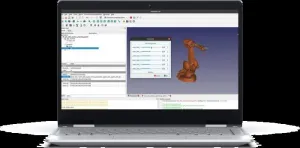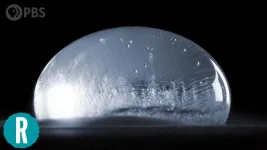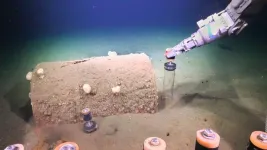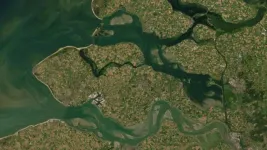(Press-News.org) Images
A new science expedition in Yampa Valley, Colorado, will improve forecasts of snowfall and estimates of how climate change will impact snowpack and water availability in the western U.S. mountains, funded with $4.8M from the National Science Foundation.
The field campaign, led by the University of Michigan, brings together scientists from the University of Washington, University of Wisconsin, University of Utah, Colorado State University and Stony Brook University. The team will use an extensive suite of radars and snow-sampling instruments to measure the size and shape of snowflakes and aerosols. The resulting catalog of data will help estimate water availability in the region, where around 67% of the water in large reservoirs comes from melting snow and low winter snowfall can lead to more severe wildfires the following summer.
"We hope that our data will ultimately improve winter storm forecasts and tell western cities when to expect a drought because of insufficient snowpack," said Claire Pettersen, an assistant professor of climate and space sciences and engineering at the University of Michigan and the lead principal investigator of the project.
The researchers will deploy more than 30 scientific instruments for studying climate and precipitation for the 2024-2025 winter season in Colorado's Park Range, a region poorly covered by the National Weather Service's radar network. The first instruments will arrive at Mt. Werner, a summit near Steamboat Springs, Colorado, this summer. Measurements will begin this December.
Collecting data over an entire winter will provide the statistical power necessary to more accurately predict snowpack after winter storms and over longer periods of time. The data catalog will go not just into an online repository for scientists, but directly to the Yampa Basin Rendezvous, a working group that brings together scientists and local water managers.
"There is a lot of discussion over how water is used in this basin, as it's a region that could help feed water to large cities downstream, and water managers need good estimates of snowfall to use that water sustainably," said Gannet Hallar, professor of atmospheric sciences at the University of Utah and director of Storm Peak Laboratory, a facility atop Mt. Werner that will house many of the instruments.
By combining snow-sampling instruments with radars that indirectly study snow, the researchers will overcome a major challenge of using radar—it's hard to connect the reflected radar signal with the size, shape and number of snowflakes, which determines the amount of water in the snow.
"We will have the actual characteristics of the snow that we can relate back to what we infer from our radar, which will improve what we can say about snow with radar in mountains moving forward," said Angela Rowe, professor of atmospheric and ocean sciences at the University of Wisconsin and a principal investigator of the study.
Without such fundamental information, today's models of snowfall often underperform in mountainous areas.
"In the West, our forecasting models and satellite estimates of precipitation really underpredict snowfall and often don't get the distribution right," said Lynn McMurdie, research professor of atmospheric sciences at the University of Washington and a principal investigator of the study.
The team's radars at Storm Peak Lab will use multiple radar frequencies for detecting snowflakes of many different sizes. At the same time, Brenda Dolan, research scientist at Colorado State University, will deploy the Sea-Going Polarimetric Radar, in Hayden, Colorado. The radar's view toward Mt. Werner and the surrounding 62 miles will be combined with the National Weather Service's radars to see how the strength of the storms change as they move toward the Rockies from the west.
The Sea-Going Polarimetric Radar can't see how clouds change inside the Yampa Valley beneath Mt. Werner because its view is blocked by the mountains. To cover the gap, Mariko Oue and Pavlos Kollias, both research assistant professors of marine and atmospheric sciences at Stony Brook University, will deploy the Ka-band Scanning Polarimetric Radar. The instrument will detect clouds and snow inside the valley up to Mt. Werner.
Blending multiple scales of data will improve what can be ascertained from radar and link changes in cloud movements to changes in the amount of water in snowflakes.
"Integrating these different scales is a very unique thing to do. The only other way to do it is with an airplane, but that is extraordinarily expensive and only provides one snapshot," said Jay Mace, professor of atmospheric sciences at the University of Utah and a principal investigator of the study.
END
Snowfall and drought: $4.8 million field campaign will improve forecasts in western US, led by U-M
A mountaintop laboratory and a suite of radar instruments will study winter storms from large-scale cloud movement down to individual snowflakes in an NSF-funded project
2024-05-06
ELSE PRESS RELEASES FROM THIS DATE:
SwRI Workbench for Offline Robotics Development™ (SWORD™) launched at Automate 2024
2024-05-06
SAN ANTONIO — May 6, 2024 – Southwest Research Institute is simplifying robotics programming with a new toolkit that embeds computer-aided design (CAD) into robotics motion planning, modeling and execution. The SwRI Workbench for Offline Robotics Development™ (SWORD™) features a user-friendly graphical interface to demystify the fundamental coding required in robot operating system (ROS) application development.
Informed by the Institute’s role in supporting the ROS-Industrial community, SwRI developed ...
Science doesn't understand how ice forms (video)
2024-05-06
WASHINGTON, May 6, 2024 — This video contains incredible macro footage of supercooled water droplets nucleating ice. All George wanted to do was make a crystal-clear ice cube. Instead, he ended up rediscovering dendritic crystal growth, a beautiful phenomenon first described in the 17th century. You’ll never look at your freezer the same way again. https://youtu.be/24TB1vPuzIU?feature=shared
Reactions is a video series produced by the American Chemical Society and PBS Digital Studios. Subscribe to Reactions at http://bit.ly/ACSReactions and ...
Study reveals APOE4 gene duplication as a new genetic form of Alzheimer's disease
2024-05-06
Researchers from the Research Area on Neurological Diseases, Neuroscience, and Mental Health at the Sant Pau Research Institute, led by Dr. Juan Fortea, Director of the Memory Unit of the Neurology Service at the same hospital, have found that over 95% of individuals over 65 years old who have two copies of the APOE4 gene -APOE4 homozygotes- show biological characteristics of Alzheimer's pathology in the brain or biomarkers of this disease in cerebrospinal fluid and PET scans.
The study, published today in Nature Medicine, also concludes that those individuals homozygous for APOE4 also develop ...
Study highlights key predictors of adolescent substance use; special issue of the American Journal of Psychiatry focuses on substance use disorders
2024-05-06
NEW YORK, May 6, 2024 – New research, published online today in the American Journal of Psychiatry, examined a broad range of potential predictors of substance use among adolescents and found sociodemographic variables were the most robust predictors of substance use initiation.
The study is part of a special issue of the journal highlighting advances in understanding the neurobiology and sociodemographic underpinnings of substance use disorders and how this understanding has advanced recognition and treatment. Several authors discussed this work today at a special briefing during the 2024 Annual Meeting of the American Psychiatric ...
Racial and ethnic disparities in initiation of direct oral anticoagulants among Medicare beneficiaries
2024-05-06
About The Study: In this cohort study of Medicare patients with atrial fibrillation, Black and Hispanic patients were less likely to initiate direct oral anticoagulants for atrial fibrillation, although these differences diminished over time. Identifying the factors behind these early disparities is crucial for ensuring equitable access to novel therapies as they emerge for Black and Hispanic populations.
Corresponding Authors: To contact the corresponding authors, email Kamika R. Reynolds, M.S., Ph.D. (kreynolds@ifh.rutgers.edu) and Chintan ...
Behavioral interventions to improve breast cancer screening outreach
2024-05-06
About The Study: These findings show that text messaging women after initial breast cancer screening outreach via either electronic portal or mailings, as well as bulk ordering with or without text messaging, can increase mammogram completion rates.
Corresponding Author: To contact the corresponding author Shivan J. Mehta, M.D., M.B.A., M.S.H.P., email shivan.mehta@pennmedicine.upenn.edu.
To access the embargoed study: Visit our For The Media website at this link https://media.jamanetwork.com/
(doi:10.1001/jamainternmed.2024.0507)
Editor’s Note: Please see the article for additional information, including other authors, author contributions ...
Venus has almost no water. A new study may reveal why
2024-05-06
Planetary scientists at the University of Colorado Boulder have discovered how Venus, Earth’s scalding and uninhabitable neighbor, became so dry.
The new study fills in a big gap in what the researchers call “the water story on Venus.” Using computer simulations, the team found that hydrogen atoms in the planet’s atmosphere go whizzing into space through a process known as “dissociative recombination”—causing Venus to lose roughly twice as much water every day compared to previous estimates.
The team will publish their findings May 6 in ...
DDT pollutants found in deep sea fish off Los Angeles coast
2024-05-06
In the 1940s and 1950s, the ocean off the coast of Los Angeles was a dumping ground for the nation’s largest manufacturer of the pesticide DDT – a chemical now known to harm humans and wildlife. Due to the stubborn chemistry of DDT and its toxic breakdown products, this pollution continues to plague L.A.’s coastal waters more than half a century later. While legal at the time, details of this industrial-scale pollution of the marine environment at a dump site some 15 miles offshore near Catalina Island ...
Turbid waters keep the coast healthy
2024-05-06
Turbid waters keep the coast healthy
To preserve the important intertidal areas and salt marshes off our coasts for the future, we need more turbid water. That is one of the striking conclusions from a new study conducted by a Dutch-Chinese team of researchers and published today in Nature Geoscience."These natural areas outside our dikes are essential for nature and coastal defense. But because how we are now building in the Delta and the hinterland, coastal defense is endangered in the long term," warns NIOZ researcher Tim Grandjean.
Satellite measurements
For his research, Grandjean linked decades of satellite measurements ...
Microscopic heart vessels imaged in super-resolution for first time at Imperial
2024-05-06
A new imaging technique tested in patients could improve the evaluation of cardiac conditions and undiagnosed chest pain.
Researchers from Imperial College London’s Department of Bioengineering and Faculty of Medicine worked alongside academics from UCL to produce sub-millimetre resolution images of cardiac micro-vessels. The non-invasive new imaging technique was tested on four human patients.
Existing imaging technologies can visualise large vessels on the heart’s surface. However, this new technique could allow scientists to study the physiology of the heart in more detail by imaging smaller micro-vessels within the heart muscle.
This research, ...
LAST 30 PRESS RELEASES:
Manta rays create mobile ecosystems, study finds
Study: Mixed results in using lipoic acid to treat progressive multiple sclerosis
Norbert Holtkamp appointed director of Fermi National Accelerator Laboratory
New agentic AI platform accelerates advanced optics design
Biologists discover neurons use physical signals — not electricity — to stabilize communication
Researchers discover that a hormone can access the brain by hitchhiking
University of Oklahoma researcher awarded funding to pursue AI-powered material design
Exploring how the visual system recovers following injury
Support for parents with infants at pediatric check-ups leads to better reading and math skills in elementary school
Kids’ behavioral health is a growing share of family health costs
Day & night: Cancer disrupts the brain’s natural rhythm
COVID-19 vaccination significantly reduces risk to pregnant women and baby
The role of vaccination in maternal and perinatal outcomes associated with COVID-19 in pregnancy
Mayo Clinic smartwatch system helps parents shorten and defuse children's severe tantrums early
Behavioral health spending spikes to 40% of all children’s health expenditures, nearly doubling in a decade
Digital cognitive behavioral treatment for generalized anxiety disorder
Expenditures for pediatric behavioral health care over time and estimated family financial burden
Air conditioning in nursing homes and mortality during extreme heat
The Alps to lose a record number of glaciers in the next decade
What makes a good proton conductor?
New science reporting guide published for journalists in Bulgaria
New international study reveals major survival gaps among children with cancer
New science reporting guide published for journalists in Turkey
Scientists develop a smarter mRNA therapy that knows which cells to target
Neuroanatomy-informed brain–machine hybrid intelligence for robust acoustic target detection
Eight SwRI hydrogen projects funded by ENERGYWERX
The Lundquist Institute and its start-up company Vitalex Biosciences Announces Strategic Advancement of Second-Generation fungal Vaccine VXV-01 through Phase 1 Trials under $40 Million Competitive Con
Fine particles in pollution are associated with early signs of autoimmune disease
Review article | Towards a Global Ground-Based Earth Observatory (GGBEO): Leveraging existing systems and networks
Penn and UMich create world’s smallest programmable, autonomous robots
[Press-News.org] Snowfall and drought: $4.8 million field campaign will improve forecasts in western US, led by U-MA mountaintop laboratory and a suite of radar instruments will study winter storms from large-scale cloud movement down to individual snowflakes in an NSF-funded project





